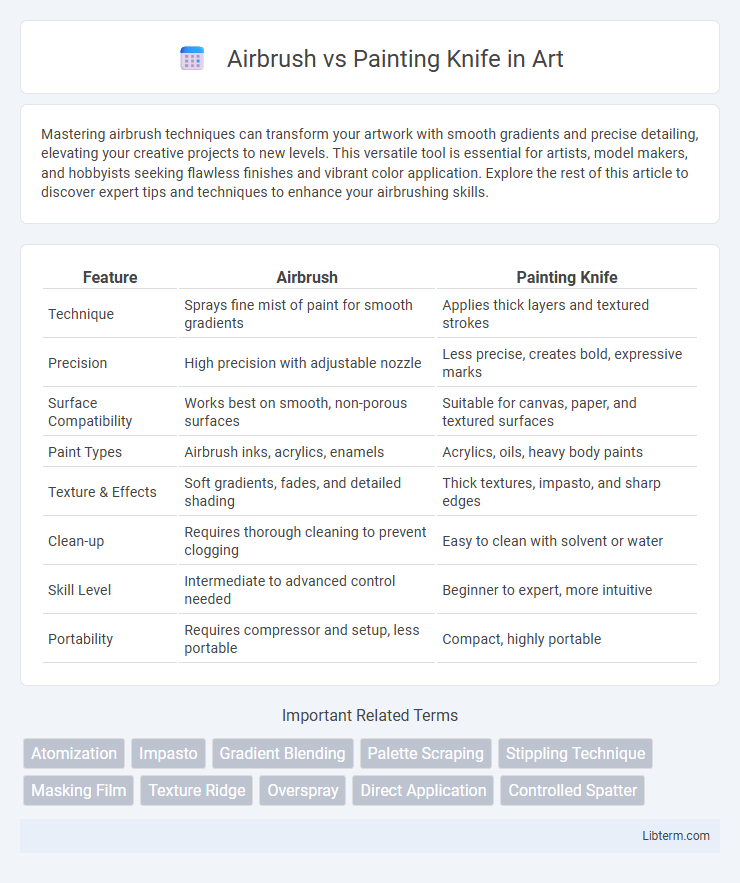Mastering airbrush techniques can transform your artwork with smooth gradients and precise detailing, elevating your creative projects to new levels. This versatile tool is essential for artists, model makers, and hobbyists seeking flawless finishes and vibrant color application. Explore the rest of this article to discover expert tips and techniques to enhance your airbrushing skills.
Table of Comparison
| Feature | Airbrush | Painting Knife |
|---|---|---|
| Technique | Sprays fine mist of paint for smooth gradients | Applies thick layers and textured strokes |
| Precision | High precision with adjustable nozzle | Less precise, creates bold, expressive marks |
| Surface Compatibility | Works best on smooth, non-porous surfaces | Suitable for canvas, paper, and textured surfaces |
| Paint Types | Airbrush inks, acrylics, enamels | Acrylics, oils, heavy body paints |
| Texture & Effects | Soft gradients, fades, and detailed shading | Thick textures, impasto, and sharp edges |
| Clean-up | Requires thorough cleaning to prevent clogging | Easy to clean with solvent or water |
| Skill Level | Intermediate to advanced control needed | Beginner to expert, more intuitive |
| Portability | Requires compressor and setup, less portable | Compact, highly portable |
Understanding Airbrush Techniques
Airbrush techniques provide smooth gradients and fine detail control ideal for realistic textures and subtle color transitions, unlike painting knives that create bold, textured strokes through direct paint application. Mastering airbrush requires understanding pressure settings, nozzle sizes, and paint viscosity to achieve precision and avoid overspray or blotching. Skilled airbrush artists exploit layering and masking methods to build depth and complex effects unavailable with painting knives.
Exploring Painting Knife Methods
Painting knife techniques create textured, bold strokes ideal for impasto effects and vibrant color blending, enabling artists to achieve dynamic, three-dimensional surfaces. Unlike airbrush methods, painting knives offer tactile control and spontaneity, making them perfect for expressing movement and depth in abstract or landscape art. Exploring diverse knife angles and pressure variations enhances the richness and complexity of the final composition.
Key Differences Between Airbrush and Painting Knife
Airbrush offers precise, smooth gradients and fine details ideal for realistic or graphic effects, while a painting knife provides bold, textured strokes suited for expressive or impasto techniques. Airbrush requires compressed air and specialized equipment, enabling controlled thin layers, whereas painting knives involve manual application of thick paint directly on the surface. The airbrush excels in seamless color blending and intricate designs, contrasting with the knife's ability to create dynamic, three-dimensional texture and sculptural paint buildup.
Surface Preparation for Each Technique
Surface preparation for airbrush techniques requires a smooth, clean, and primed surface to ensure even paint application and prevent clogging of the airbrush nozzle. Painting knife surfaces need minimal preparation but benefit from a slightly textured or thickly primed canvas to hold and manipulate thick layers of paint effectively. Proper surface priming tailored to each method enhances adhesion, color vibrancy, and durability in both airbrush and painting knife art.
Achieving Textures: Airbrush vs Painting Knife
Achieving textures with an airbrush involves creating smooth gradients and fine details through controlled layers of paint, ideal for subtle shading and realistic effects. In contrast, a painting knife produces bold, tactile textures by applying thick, impasto strokes that add physical dimension and dynamic movement to a surface. Artists often combine airbrush for delicate nuances with knife techniques to achieve multidimensional, rich textural contrasts in their work.
Color Blending and Layering Approaches
Airbrush techniques enable smooth, gradient color blending by applying ultra-fine, controlled sprays of pigment, resulting in seamless transitions and soft edges ideal for realistic shading. Painting knives, in contrast, create bold, textured layers through thick, impasto strokes, emphasizing distinct color separations and dynamic surface build-up rather than gradual blending. Mastering airbrush requires precision in pressure and distance control, while painting knife artistry relies on tactile manipulation of paint thickness and layering direction for expressive effects.
Suitable Art Styles for Airbrush and Painting Knife
Airbrush suits art styles requiring smooth gradients and fine details, such as photorealism, illustration, and automotive art, due to its ability to spray controlled layers of paint. Painting knives excel in impasto and textured styles like expressionism and abstract art, where bold, thick strokes and sculptural paint applications create dynamic surface effects. Each tool enhances specific artistic techniques based on the desired texture and precision.
Tools and Materials Needed
Airbrush systems require an air compressor, a spray gun, and specialized inks or acrylic paints designed for fine atomization, enabling smooth, even coverage and intricate detailing. Painting knives, typically made of stainless steel or plastic with flexible blades in various shapes and sizes, demand thicker acrylic or oil paints for creating textured, impasto effects. Both tools necessitate specific cleaning supplies--airbrush cleaners and water or solvents for knives--to maintain optimal performance and longevity.
Pros and Cons of Airbrush vs Painting Knife
Airbrush offers precise control and smooth gradients ideal for detailed and realistic artwork, but requires extensive setup and maintenance, making it less portable than a painting knife. Painting knives provide bold texture and dynamic strokes suitable for creating impasto effects, yet lack the fine detail and subtle shading achievable with an airbrush. Choosing between airbrush and painting knife depends on the desired artistic style, project complexity, and medium compatibility.
Choosing the Right Technique for Your Artwork
Choosing between airbrush and painting knife techniques depends on the desired texture and detail of your artwork. Airbrushing allows for smooth gradients and precise control, ideal for photorealistic effects and delicate shading. Painting knives create bold, textured strokes and dynamic layers, perfect for expressive, impasto styles and adding dimensionality to oil or acrylic paintings.
Airbrush Infographic

 libterm.com
libterm.com